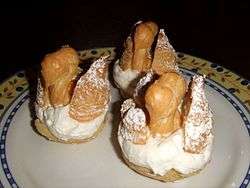Choux pastry
|
Choux pastry swans | |
| Alternative names | Pâte à choux |
|---|---|
| Type | Pastry |
| Place of origin | France |
| Creator | Panterelli |
| Main ingredients | butter, flour, eggs, water |
|
| |
Choux pastry, or pâte à choux (pronounced: [pɑt a ʃu]), is a light pastry dough used to make profiteroles, croquembouches, éclairs, French crullers, beignets, St. Honoré cake, quenelles, Parisian gnocchi, dumplings, gougères, chouquettes and craquelins. It contains only butter, water, flour and eggs. Instead of a raising agent, it employs high moisture content to create steam during cooking to puff the pastry. The pastry is used in many European and European-derived cuisines.
History
According to some cookbooks,[1] a chef by the name of Pantarelli or Pantanelli invented the dough in 1540, seven years after he left Florence with Catherine de' Medici and her court. He used the dough to make a gâteau and named it pâte à Pantanelli. Over time, the recipe of the dough evolved, and the name changed to pâte à popelin, which was used to make popelins, small cakes made in the shape of a woman's breasts. Then, Avice, a pâtissier in the eighteenth century, created what were then called choux buns. The name of the dough changed to pâte à choux, as Avice's buns resembled cabbages—choux in French.
From there, Antoine Carême made modifications to the recipe, resulting in the recipe most commonly used now for profiteroles.[2]
Essential ingredients and manner of rising
The ingredients for choux pastry are butter, water, flour and eggs. Like Yorkshire Pudding or David Eyre's pancake, instead of a raising agent, it employs high moisture content to create steam during cooking to puff the pastry. The high moisture content is achieved by boiling the water and butter, then adding the flour. The mixture is cooked a few minutes longer, then cooled before adding enough eggs to achieve the desired consistency. The boiling step causes the starch in the flour to gel, allowing the incorporation of more water.[3]
Foods made with choux pastry
This pastry is used to make profiteroles, croquembouches, éclairs, French crullers, beignets, St. Honoré cake, quenelles, Parisian gnocchi, dumplings[4] and gougères.
Choux pastry is usually baked but for beignets it is fried. In Spain and Latin America, churros are made of fried choux pastry, sugared and dipped in a thick hot chocolate for breakfast. In Austrian cuisine, one variation of Marillenknödel, a sweet apricot dumpling[5] cooked in simmering water, uses choux pastry; in that case it does not puff, but remains relatively dense. Choux pastries are sometimes filled with cream after baking to make cream puffs or éclairs.[6]
Chouquettes, named for the diminutive of "choux," are small, round, hollow choux pastry covered with large-grain sugar. Craquelins are covered in a "crackly" sugar topping - and often filled with pastry cream, much like eclairs.
- Mixing choux pastry dough for beignets
- Piping out the dough for beignets with a pastry bag
See also
- List of choux pastry dishes
- List of pastries
-
 food portal
food portal
References
- ↑ the chefs of Le Cordon Bleu (2011). Le Cordon Bleu patisserie foundations. Clifton Park, N.Y.: Delmar. ISBN 9781439057131.
- ↑ Juillet, Claude (1998). Classic Patisserie: An A–Z Handbook. Butterworth-Heinemann. ISBN 0-7506-3815-X.
- ↑ McGee, Harold (2004). On Food and Cooking : The Science and Lore of the Kitchen (Completely rev. and updated. ed.). New York, NY [u.a.]: Scribner. pp. 552–553, 612. ISBN 0-684-80001-2.
- ↑ Henri-Paul Pellaprat, Jeremiah Tower, The Great Book of French Cuisine, 2012
- ↑ "Recipe for this variation of Marillenknödel (in German).".
- ↑ "Basics: Choux pastry". Just Hungry. 2004-04-06. Retrieved 2010-09-08.
External links
| Wikimedia Commons has media related to Choux pastry. |
| Look up choux pastry or pâte à choux in Wiktionary, the free dictionary. |
